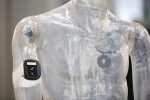According to the International Trade Administration and BCC Research, the sales volume for the global market for medical implants is estimated at €30–60 billion, with active implants comprising approximately €15 billion. “Active” is defined as any implant fitted with an energy source (i.e., a battery). However, other types of power supplies, such as induction, also fall into this category.
“The new combinations of types of technology and the integration of electronics, smaller components, high frequency and wireless technology as well as monitoring, recording and control systems are market drivers for implants at the moment,” says Dick Molin, medical market segment manager for Specialty Coating Systems (SCS).
Active implants are some of the most technically tricky and risky medical devices, placing a bigger burden on R&D, production and regulatory approval. Innovations must always consider patient safety, reliability throughout their lifecycle, biological compatibility and biostability as well as compatibility with other medical technologies.
Active Implants: Pacemakers, Where It All Began
The development of active implants began before 1958, when the first pacemaker was implanted at the Swedish Karolinska Institute. Since then, numerous devices for electric stimulation, improving hearing, delivering medication or for use as dental prostheses have become common. Orthopedic implants for distraction osteogenesis, implants for supporting cardiac function and sensors that measure intracranial and intraocular pressure, bladder pressure or blood sugar levels are also part of this category.
Neuroprosthetics is an important part of the active implants field. In this sector, CorTec has developed a closed-loop system for measuring and stimulating brain activity for long-term use. “The driving premise behind our work is the realization that these kinds of therapies need to be personalized,” says Martin Schüttler, Ph.D., founder and chief technology officer of CorTec. The brain interchange concept consists of three components: Electrodes for recording and stimulating the nervous system, a telemetric unit for optical communication with both the implant, and the computer unit that evaluates the brain signals in real time to determine how much stimulation the patient requires. The electrodes consist of five layers that are created using ultrashort pulse lasers and microfabrication methods. They can be constructed into any geometric shape (three dimensional or in a cuff design), with high-contact density and for a wide variety of applications.
New materials, innovative procedures and the combined application of electronics and microsystem technology are not only typical for modern implants but are also fundamental main themes at COMPAMED 2018, which takes place November 12–15 in Düsseldorf, German. The trade fair will not only showcase the latest developments in this field but will also present many other fields of research, such as digitalization and miniaturization in medical technology.Biodegradable Materials for Resorbable Implants
Many implants require a lifespan that is as long as possible, but for others, it is important that they do not remain in the body long term. At the IFAM (Fraunhofer Institute for Manufacturing Technology and Advanced Materials) in Dresden (Germany), a biodegradable magnesium implant with a fibrous structure has been developed to treat major bone defects. It acts as a guiding structure for the bone while it is growing, with the growth stimulated by the biomechanical properties of the implant. This structure also stimulates blood vessel growth simultaneously. The implant degrades as the healing process progresses. Major bone damage has typically been treated by grafts taken from a patient’s own bones and thus has limitations. In addition, harvesting the graft, which generally comes from the iliac crest, harbors additional risks for patients. Synthetic bone replacements represent an alternative, but they often can withstand minimal mechanical stress and are unsuitable as a result of the disruptions they cause in imaging in the long term.
As a result, biodegradable materials represent the ideal solution; they are used to create implants that disappear once the healing process is complete. One such example is the magnesium implant from the Fraunhofer IFAM in Dresden. The starting point for development is the manufacturing of short magnesium fibers via extraction from the melt. These fibers are then homogeneously deposited and bonded to each other and densified via heat treatment. These implants have excellent mechanical and corrosion properties. In the animal model, slow corrosion was thus first measured after 12 weeks, and after 24 weeks, the majority of the metallic component had disappeared. Osteosynthesis and cardiovascular stents are considered the most significant commercial applications for this technology.
“Sword Catheters” = Easy Puncturing of Blood Vessels
Puncturing blood vessels is the first step for inserting catheters into vessels, which feed medication, perfusions and other elements into patients; it is an indispensable for emergency cases that require blood transfusions. Generally, the Seldinger technique, which was published in 1953, is performed for opening larger blood vessels when puncture systems are used. This technique takes up a lot of time, space and uses a lot of material, and the doctor performing it also needs an assistant for standard cases. The Seldinger technique has many individual steps and the procedure can last up to approximately 30 minutes. With this in mind, Jens Ebnet, M.D., founder and CEO of Ebnet Medical, developed the SWORDCATH, a puncture system that contains all the necessary components for the procedure. “Our system uses a puncture technique that is new and can be learned intuitively. It also combines a small puncture needle with a large catheter,” says Ebnet. The new solution, which has been registered for patents in many countries, cuts down the procedure time significantly and can be completed by one person without additional assistance.







